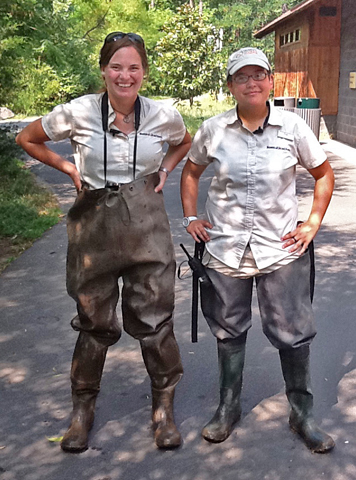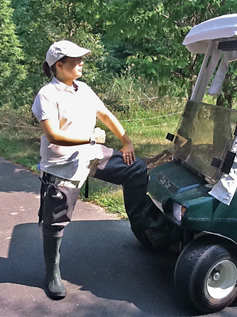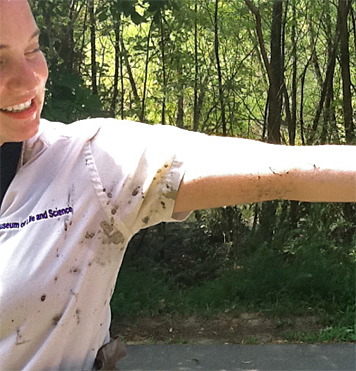

What’s got Sara and Erin smiling on a steamy morning in mid summer? Well, they just got back from a walk in the Wetlands. Who wouldn’t be smiling after spending time in a swamp full of frogs, snakes, all forms of aquatic (and flying) insects, and of course, muddy water.
What were they doing braving the heat and humidity of the day? They were testing locations and equipment in order to collect data on temperature, turbidity, and acidity of the water.
What do they hope to find out by testing the water in the Wetlands? Well, you never really know for sure what collected data will tell you, but hopefully it will help in spotting trends in water quality throughout the seasons.
Outside environmental factors including rain, heat, and even wildlife usage by visitors such as Canada Geese as well as various plant species that enter the habitat also have an influence on water quality. Perhaps those influences will be evidenced in the data.
The Wetlands seems to be a rather healthy environment despite the fact that most of the water within it comes from runoff from the surrounding neighborhoods. The Museum is smack in the middle of suburbia here in Durham and what’s on the roads of Durham often makes it into the Wetlands.
The water is filtered by many wetland plants like the numerous willows that are present (although one plant species is mysteriously missing this season). Studies in the past had shown that the water that left the Wetlands was in fact cleaner than the water that entered the habitat. But even with the filtration, and this is purely anecdotal, the water seems more turbid than in previous years.
A testament to the water’s ability, in the past, to support life is perhaps the 13 species of frogs and toads that have been seen or heard here, the 34 species of odonata that have been recorded here, and the many aquatic invertebrates that live and thrive in the water that slowly moves through the old rock quarry that is our Wetlands. The plants, up until now at least, have apparently been doing a their job. It’s curious, though, why cattails have not taken hold in the Wetlands. Cattails would add to the filtration process, with the added benefit of attracting various new wildlife species.
The two intrepid Rangers, Sara and Erin, are still perfecting their methods and calibrating instruments. We’ll see what happens as the Rangers get their studies rolling along in full gear.
In the mean time…trekking in the Wetlands is not without its hazards.

Enjoy!